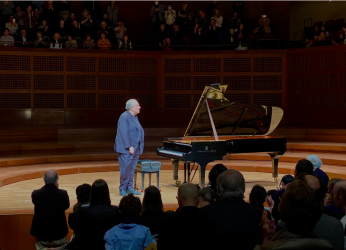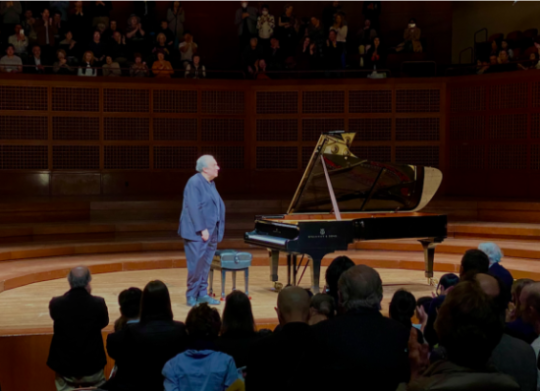 United States Various: Yefim Bronfman (piano). San Francisco Symphony Great Performers, Davies Symphony Hall, San Francisco, 21.4.2024. (HS)
United States Various: Yefim Bronfman (piano). San Francisco Symphony Great Performers, Davies Symphony Hall, San Francisco, 21.4.2024. (HS)

Schubert – Piano Sonata in A minor, D.784
R. Schumann – Faschingschwank aus Wien
Esa-Pekka Salonen – ‘Sisar’
Chopin – Nocturne No.2 in D-flat major, Op.27
Prokofiev – Piano Sonata No.7 in B-flat major, Op.83
Pianist Yefim Bronfman brings subtle shading and an eye-opening technique to familiar pieces. His work on Schubert’s familiar Piano Sonata in A minor and Robert Schumann’s somewhat less-familiar Faschingschwank aus Wien suite in the first half of this concert was refined and elegant, but the big thrills came after intermission.
Presented in recital by San Francisco Symphony’s Great Performers series, Bronfman unleashed a torrent of intensity and dexterity to drive Prokofiev’s Piano Sonata No.7 to a hair-raising climax. It was bravura playing, never over-the-top although it threatened to lift the audience out of its seats. Actually, it did – the rapt attendees leaped to their feet as if propelled. What mattered was the way Bronfman harnessed the composer’s bumptious rhythms, let phrases breathe when the intensity ebbed in the middle movement, and held back just enough energy in the long build-up to the finale’s crashing climax.
Prokofiev’s quirky tempo markings underline the restless energy of the piece. In the first movement, Allegro inquieto, Bronfman established a patent anxiety with crisp staccatos and contrasts between brutal chords and lyrical interludes. The slow movement, Andante coloroso (which translates to ‘warmly’), developed an uncanny richness in tone, itself building to full-throated, expansive chords before receding nicely into softness.
The finale, marked Precipitato (which translates to ‘hurried’), flung itself into frantic, even somewhat jazzy rhythms. The music looks chaotic on the page, but Bronfman wrestled it all into a coherent narrative that gained momentum phrase-by-phrase until it hit the big B-flat chord at the end. Even Bronfman looked a little dazed as he stood for applause, perhaps because it was such a hard-won victory.
The opening Schubert sonata, a late work that included some of the composer’s most experimental harmonies, got a well-regulated performance, tiny emphases here, a bit of rubato there, all to bring an extra helping of elegance to the ominous music. An undertone of pain colored the Andante, and the faster parts of the Allegro giusto opening movement and the Allegro vivace finale revealed a variety of touches (a signature of this pianist’s style).
Schumann’s colorful musing on Vienna’s carnival season was more entertaining, especially in the three short middle movements – a Romanze, a Scherzino and an energetic Intermezzo. Each one has a wistful feel, which contrasts with the brash, outgoing opening Allegro and the Finale, a sonata allegro form that ran hell-bent under the pianist’s accurate execution.
The second half opened with a six-minute prelude written by Esa-Pekka Salonen for Bronfman that premiered in 2013 in Los Angeles while Salonen was music director of the LA Philharmonic. (The pianist is back in June to play Schumann’s Piano Concerto with Salonen conducting.) Rhapsodical in its shifts from mild dissonance to pretty lyricism, ‘Sisar’ brought out another of the pianist’s positive traits, the ability to make complex music sound perfectly logical.
Even better was the Chopin Nocturne in D-flat major, in which Bronfman’s pixie-like touch made the exotic embellishments shimmer, and his impeccable sense of balance brought out just the right voice in the harmonies and melodies. The final measures floated away with a sigh.
That set up the ferocious Prokofiev sonata perfectly, after which two encores – both familiar offerings from Bronfman – showed off his strengths. In Robert Schumann’s Arabeske in C major, Bronfman fashioned the filigrees of fast-moving notes into something resembling waves of birds in flight, weaving like clouds this way and that. Rachmaninoff’s Prelude in G minor stomped its way in with a touch just stern enough to give it appropriate weight. This gave way to a lyrical middle section that benefited from graceful, quick arpeggios in the left hand before returning to the march with extra zest.
Harvey Steiman
